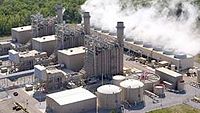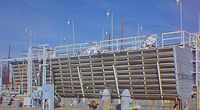CZ:Featured article/Current
Industrial cooling tower
Industrial cooling towers are heat rejection systems used primarily to provide circulating cooling water in large industrial facilities. The circulating cooling water absorbs heat by cooling and/or condensing the hot process streams or by cooling hot rotating machinery and other hot equipment within the industrial facilities. The cooling towers then reject that absorbed heat by transferring it to the atmosphere.
How a cooling tower works
Basically, a cooling tower intimately contacts a flow of warm water with a flow of ambient air which is not saturated with water vapor (i.e, air which contains less water vapor than it is capable of containing). That causes part of the warm water to evaporate and the air absorbs that evaporated water. The heat required to evaporate part of the water is derived from the water itself and thus causes the water to cool. This process is known as evaporative cooling.[1][2] The net result is that the air leaving the tower is saturated with water vapor and the unevaporated water leaving the cooling tower has been cooled.
An evaporative cooling tower is referred to as a wet cooling tower or simply a cooling tower. Such towers can cool water to a temperature that approaches the wet-bulb temperature of the ambient air. The average ambient air wet-bulb temperature chosen as the design basis essentially determines the size of the cooling tower, and the size of a cooling tower is inversely proportional to the design wet-bulb temperature.
| notes |
|---|
|

